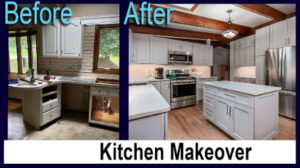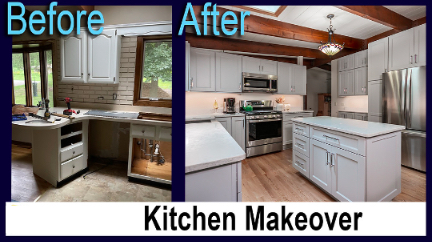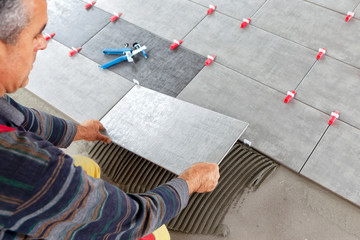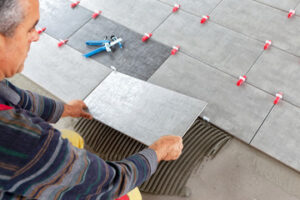 If you want to improve your kitchen look, you’re probably considering a kitchen counter renovation. However, you may be wondering which materials are best for the job. Quartz countertops are among the most popular choices and Natural stone countertops are also popular. Other popular choices include Soapstone and Paper composite countertops, which are stain-resistant and easy to install. Here are some tips on choosing the right materials for your Kitchen Remodeling Tacoma WA project.
If you want to improve your kitchen look, you’re probably considering a kitchen counter renovation. However, you may be wondering which materials are best for the job. Quartz countertops are among the most popular choices and Natural stone countertops are also popular. Other popular choices include Soapstone and Paper composite countertops, which are stain-resistant and easy to install. Here are some tips on choosing the right materials for your Kitchen Remodeling Tacoma WA project.
Natural stone countertops are in high demand
If you’re looking for an elegant countertop material for your kitchen, natural stone is the way to go. These stone countertops can be made of various materials, including marble, granite, soapstone, quartzite, slate, and more. Marble has a classic appeal, as well as striking vein patterns. These countertops require periodic sealing and professional finishing, but they are worth the investment. If you want a gorgeous counter for a low price, consider a marble or granite countertop.
A popular countertop material is granite, which is durable and resistant to heat, acids, and scratches. It is available in hundreds of colors, including veining and flecks. Marble has a beautiful, speckled look and requires less maintenance than granite, but its smooth surface does require some maintenance. Quartzite is engineered from quartz dust, while granite is naturally occurring. Limestone is a more affordable option and offers beautiful patterns but needs more upkeep.
One of the biggest advantages of natural stone countertops is their durability. They can last for decades, requiring only basic care. But unlike other stone materials, they require periodic sealing and maintenance. This is because limestone can become stained or etched by acidic materials. With proper care, natural stone countertops can last a lifetime and enhance your home’s value. Natural stone countertops are also available in different species and finishes, so you can choose one that best suits your taste and your kitchen’s style.
If you’re looking for a less expensive natural stone option than marble or granite, you may want to consider dolomite. Dolomite is a sedimentary rock that forms naturally when limestone meets magnesium-rich groundwater. It’s usually white or gray in color, with streaks, and resembles marble better than quartzite. A beautiful stone countertop will make your kitchen look more elegant and modern!
Quartz countertops are the most popular choice
While granite is still the most popular material for kitchen counters, quartz is a popular alternative to granite and other stone materials. These stone countertops come in a variety of textures and finishes, including honed, matte, and suede. Some brands are renowned for their artisanal details, while others are more practical for everyday use. If you’re in the market for a new kitchen countertop, quartz may be the best choice.
Another reason quartz is so popular is that it is incredibly stain-resistant. Although quartz is extremely hard and scratch-resistant, it can still stain if liquids are left on it for too long or if the wrong cleaning solution is used. The great thing about quartz is that it’s very hard to scratch or chip, but it can still be damaged by high-powered tools. Although quartz is virtually impenetrable, improper cleaning methods can cause it to lose its shine and luster.
Another major advantage of quartz is its color variety. While granite is available in a variety of shades, quartz’s uniform color and pattern make it easier to match the tile around your kitchen. You can also choose to have a plain white quartz countertop, or choose one with a pattern or textured surface for a more stylistic look. And if you’re not into the honed look, you can always opt for polished quartz.
If you’re looking for a more affordable option than granite or marble, you may want to consider using engineered quartz as your material. This man-made material is made of 93 percent quartz particles. It is made by bonding a natural quartz base with a mixture of resins. As a result, quartz countertops are more durable than other materials and can even mimic the look of marble and granite. Unlike granite and marble, quartz countertops don’t need annual sealing and can last for decades.
Soapstone countertops are stain resistant
If you’re considering adding soapstone countertops to your home, then you’ll be happy to hear that they’re naturally stain resistant and require no sealing. Although the stone doesn’t need to be sealed, applying mineral oil to the surface of the countertop can speed up the process of natural darkening and bring out the sheen. The patina will naturally take seven to nine months to develop and can be enhanced by adding a few drops of mineral oil. If you’d like to speed up the process, a small paint brush may be handy for corners.
Soapstone countertops are also extremely durable. They come in a wide array of colors, but are not available in pastel hues. Soapstone countertops are durable and stain resistant, and they’re almost maintenance-free. Although they can scratch, they’re easy to repair with a cutting board. And because they’re a great choice for eco-friendly homes, they’re also quite affordable.
Soapstone countertops can withstand stains, but some substances stain them more easily than others. While granite countertops are naturally stain resistant, some varieties are porous. For best results, clean up spills quickly and frequently, as soapstone tends to oxidize with use. Also, mineral oil is recommended for maintaining soapstone’s stain-resistant qualities. A little bit of mineral oil will go a long way.
Although soapstone countertops are not completely stain-proof, they’re easy to maintain. They require only water and mild soap to clean. Unlike granite and other materials, soapstone countertops can be damaged by a sharp knife, but most of these issues can be repaired easily. If you’re worried that your soapstone countertops will get stained, consider installing cutting boards. And if your countertops do get damaged, you can always replace them.
Paper composite countertops are easy to install
If you are planning to redo your kitchen, consider installing paper composite countertops. These countertops are made from large sheets of recycled paper. Some manufacturers use post-consumer recycled paper, while others use paper from sustainable sources. Both types have the same basic construction and installation process, except that the paper is soaked in special resin and then compressed under high pressure. DIY homeowners can install them in their kitchens without a professional’s help.
Paper composite countertops are as tough as natural stone options. They can withstand light scratches from dropped knives and the marks from cutting boards, and are stain-resistant and easy to maintain. Paper composite countertops can last up to 25 years with regular care. Paper composite countertops should be sealed once or twice a year. To clean them, simply wipe them with a damp cloth and mild dish soap. Avoid harsh chemicals, including bleach, as they will dull them.
One disadvantage of paper composite countertops is that they are not available in light shades. Although they look like stone, they are much softer to touch and tend to go with lighter-colored cabinets. However, these countertops can still be installed by contractors and are easy to clean. They are also relatively inexpensive, so they are an excellent option for kitchen renovation projects. You can even install paper composite countertops yourself without hiring a contractor.
Paper composite countertops are easy to install in kitchens and can be used in the bathroom. While the materials used in their production vary, the basic installation process is easy. You do need to know the material’s thickness and whether it will be suitable for the kitchen. You should also consider if it can withstand heat. As a general rule, paper composite countertops are not heat resistant over 350 degrees Fahrenheit. Therefore, if you are planning to install paper composite countertops, make sure to use pot holders or trivets under hot cookware.
Reclaimed wood countertops are eco-friendly
Reclaimed wood countertops are not only environmentally friendly, they are also beautiful. They are made of old growth trees, making them sturdy enough to withstand daily use. Not only is this kind of wood beautiful, but it adds substance to the home and history. Not to mention, it is a great option if you’re planning to renovate your entire home. Read on to learn about the benefits of reclaimed wood countertops for your kitchen renovation project.
Reclaimed wood is an excellent option for kitchen countertops. This type of wood is the most eco-friendly wood for kitchen renovations because it is not a product of clear-cutting. Bamboo is another green alternative. Reclaimed wood will preserve the unique tarnishing of the countertops for a long time. This type of wood also is great for kitchens that need a more contemporary look. These countertops can also be found in many different styles.
Reclaimed wood countertops can be expensive compared to new ones, but they are worth it. The dealers and distributors of these countertops do a thorough check on their raw materials for pest infestations, and they ensure that the wood is free of contaminants. Reclaimed wood countertops cost anywhere from $40 to $80 per square foot, but are often more expensive than regular butcher block. You must also be aware that reclaimed wood countertops will need to be re-sealed on a regular basis, so they shouldn’t be installed next to a dishwasher or sink.
Reclaimed wood is unique, and you can find different species in it. These woods were used in buildings of old. Some wood species were used for homes in different areas, so they won’t be easily available in the market today. Moreover, they are stronger than new wood, so you can rest assured that reclaimed wood countertops will not tear or break under regular use. They are also unique and provide a unique look for your countertops.


 Laying The Tiles
Laying The Tiles